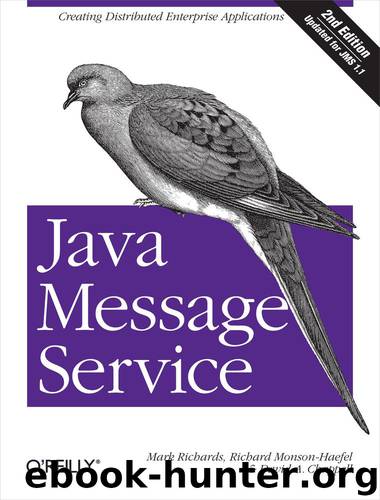Java Message Service by Mark Richards Richard Monson-Haefel & David A Chappell

Author:Mark Richards, Richard Monson-Haefel & David A Chappell
Language: eng
Format: epub
Tags: COMPUTERS / Programming Languages / Java
ISBN: 9780596802219
Publisher: O’Reilly Media
Published: 2009-05-18T16:00:00+00:00
Enterprise JavaBeans 3.0 (EJB3) Overview
The release of the EJB3 (JSR-220) specification in 2006 marked a significant turning point for EJB and Java EE in general. The primary theme of EJB3 is simplification and it achieves this goal very nicely. In addition to simplifying the development and deployment of Enterprise JavaBeans, the EJB3 specification added a new ORM-based persistence framework called JPA aimed at replacing the EJB 2.1 Entity Beans (which are no longer supported in EJB3).
One of the goals of the EJB3 specification is to address several issues found in the EJB 2.1 specification. Some of these issues included the dependency on a framework for the development of Enterprise JavaBeans (i.e., implementing and extending specific EJB interfaces), the need for home and remote interfaces, verbose and complex XML deployment descriptors, and the Entity Bean persistence model.
One of the significant productivity improvements in EJB3 is the use of Java metadata annotations over XML deployment descriptors (e.g., ejb-jar.xml). Of course, you can still choose to use XML deployment descriptors rather than annotations or you can use both XML and annotations together. When used in conjunction with annotations, the XML deployment descriptor overrides any matching configuration specified by the metadata annotation.
Other major features of the EJB3 framework include simplified bean development, the use of dependency injection, simplified callback methods for session and message-driven beans, the use of programmatic defaults that actually make sense, interceptors, and finally, the JPA. A description of each of these features is discussed in the following sections.
Download
This site does not store any files on its server. We only index and link to content provided by other sites. Please contact the content providers to delete copyright contents if any and email us, we'll remove relevant links or contents immediately.
| Coding Theory | Localization |
| Logic | Object-Oriented Design |
| Performance Optimization | Quality Control |
| Reengineering | Robohelp |
| Software Development | Software Reuse |
| Structured Design | Testing |
| Tools | UML |
The Mikado Method by Ola Ellnestam Daniel Brolund(20724)
Hello! Python by Anthony Briggs(20010)
Secrets of the JavaScript Ninja by John Resig Bear Bibeault(18332)
Dependency Injection in .NET by Mark Seemann(18209)
The Well-Grounded Java Developer by Benjamin J. Evans Martijn Verburg(17688)
OCA Java SE 8 Programmer I Certification Guide by Mala Gupta(17496)
Kotlin in Action by Dmitry Jemerov(17308)
Adobe Camera Raw For Digital Photographers Only by Rob Sheppard(16937)
Algorithms of the Intelligent Web by Haralambos Marmanis;Dmitry Babenko(16319)
Grails in Action by Glen Smith Peter Ledbrook(15467)
Test-Driven iOS Development with Swift 4 by Dominik Hauser(10417)
Becoming a Dynamics 365 Finance and Supply Chain Solution Architect by Brent Dawson(8056)
Microservices with Go by Alexander Shuiskov(7820)
Practical Design Patterns for Java Developers by Miroslav Wengner(7724)
Test Automation Engineering Handbook by Manikandan Sambamurthy(7672)
Angular Projects - Third Edition by Aristeidis Bampakos(7160)
The Art of Crafting User Stories by The Art of Crafting User Stories(6611)
NetSuite for Consultants - Second Edition by Peter Ries(6534)
Demystifying Cryptography with OpenSSL 3.0 by Alexei Khlebnikov(6305)
